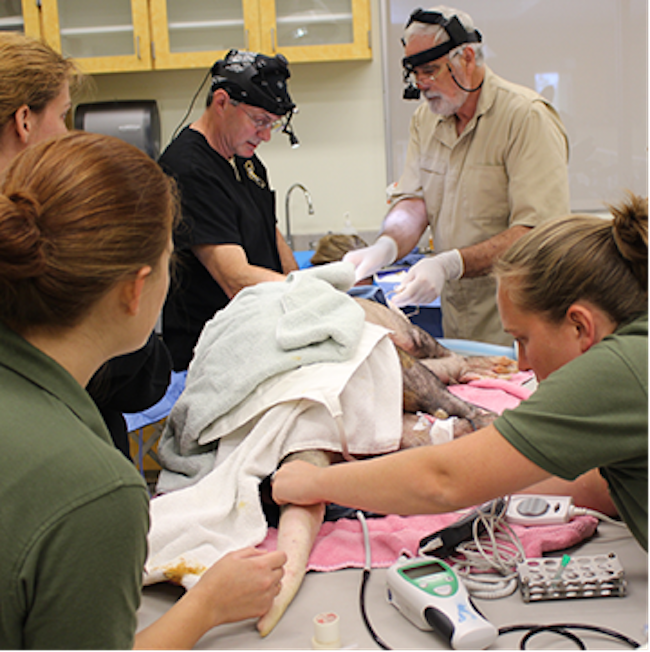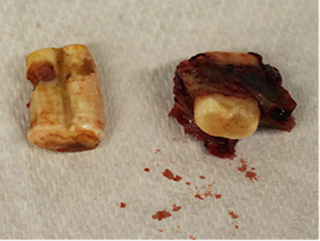Say 'Aaaah': Zoo's Aardvark Gets 2 Teeth Pulled

Getting a tooth pulled is never fun, but it's especially irksome if you're an aardvark. Ali, an aardvark at the Cincinnati Zoo, recently learned this lesson firsthand after two infected teeth landed her in the dentist's chair.
Aardvarks, the only extant species in the order Tubulidentata, are unusual animals — and they have unusual teeth, said Jack Easley, a Kentucky-based veterinarian who specializes in dentistry. Easley was one of several veterinarians who helped extract Ali the aardvark's two problematic teeth last month at the Cincinnati Zoo.
Unlike most other mammals, aardvarks don't have enamel in their teeth. (Enamel is the hard, visible part of the tooth that covers up the more sensitive tissues beneath it.) These soft teeth typically serve aardvarks well, because in their native African habitat, the animals only eat easy-to-chew insects like termitesand ants, Easley told Live Science. [Photos: World's Cutest Baby Wild Animals]
But in zoos, aardvarks don't always eat soft insects, which may not be readily available. Instead, they eat a special, pelleted feed or some other manufactured food, said Easley, who noted that, sometimes, this diet can lead to dental disease. Ali, who is 11 years old, is also middle-age for an aardvark, which may have contributed to the decline in her dental health, he added.
Zoo staff first noticed that there was a problem with the animal's health back in January, when Ali developed a weird-looking, swollen eye. The problem seemed to be resolved with a dose of antibiotics, but when the medication was finished, the ulcer came back, said Jenny Nollman, an associate veterinarian at the Cincinnati Zoo.
"When it didn't clear up completely, we investigated it further," Nollman told Live Science. "That's when we got into the CT [cat scan] and MRI [magnetic resonance imaging] — the more advanced imaging — to try to really get a better diagnosis."
In July, zoo staff accompanied Ali to a nearby hospital to try to pinpoint the root of the problem. The CT scan and MRI suggested that what appeared to be an eye problem was actually a tooth problem, Nollman said. That's when zoo vets reached out to Easley, one of very few veterinarians in the United States who is board-certified in veterinary dentistry.
Sign up for the Live Science daily newsletter now
Get the world’s most fascinating discoveries delivered straight to your inbox.

Two of Ali's molar teeth were so infected that the bone and tissue supporting her teeth had formed what's known as a periodontal pocket, Easley said. This led to the formation of a fistula, or an abnormal passageway between two body parts that are not usually connected. In Ali's case, the fistula formed between her sinus and the periorbital sac (the tissue surrounding the eyeball), causing her eyeball to look inflamed and leak out pus.
To fix this problem, Easley and another certified veterinary dentist traveled to Cincinnati to pull out Ali's infected teeth. But there was one small problem: Unlike humans, aardvarks can't say "ah."
In addition to having weird teeth, aardvarks have strange mouths. The animals have long tongues and deep oral cavities, with the teeth located all the way in the back (about 12 inches, or 30 centimeters, inside their mouths). These oral openings are very small, measuring only 1.5 inches (4 cm) across, according to Easley.
To reach inside Ali's mouth, Easley had to make a small incision in the animal's cheek. After removing the two infected molars, the veterinarians packed the hole left by the extracted teeth with an antibiotic-coated gauze material and left Ali to heal over the next three to six weeks.
Yesterday (Sept. 1), Nollman performed a checkup, and the resilient little aardvark seemed to be doing quite well, she said, though it will take Ali a few more weeks to fully heal.
"[Ali] has not missed a beat through this whole thing," Nollman said. "Her appetite has never decreased, and she has been very active."
Ali is still on exhibit at the Cincinnati Zoo alongside Diggy, her male aardvark companion. Members of the public can follow this tough critter's antics (and keep tabs on her recovery) by following #AliTheAardvark on Facebook and Twitter.
Follow Elizabeth Palermo @techEpalermo. Follow Live Science @livescience, Facebook & Google+. Original article on Live Science.

Elizabeth is a former Live Science associate editor and current director of audience development at the Chamber of Commerce. She graduated with a bachelor of arts degree from George Washington University. Elizabeth has traveled throughout the Americas, studying political systems and indigenous cultures and teaching English to students of all ages.











